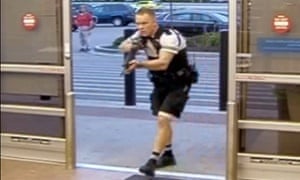 Police officer Sean Williams enters an Ohio Walmart just before John Crawford III was fatally shot while holding an unloaded BB gun in August. Photograph: CCTV
Police officer Sean Williams enters an Ohio Walmart just before John Crawford III was fatally shot while holding an unloaded BB gun in August. Photograph: CCTV
Tom McCarthy in New York @TeeMcSee
Thursday 9 April 2015 12.56 BSTLast modified on Thursday 9 April 201513.00 BST
A stark new video of a white police officer shooting an unarmed black man in the back in South Carolina has reignited a sense of public outrage over US police killings that has been smoldering since last summer – but there is little to suggest that this latest dispatch of the YouTube era will shake confidence in police, especially among affluent white Americans.
Ubiquitous video technology – from smartphones and dashboards to surveillance and body cameras – has produced an increasing trail of grainy footage of citizen deaths turned cultural flashpoints, from Rodney King to Oscar Grant, Eric Garner to 12-year-old Tamir Rice and many more. Yet public trust in the police has remained relatively steady – and consistently divided along racial lines.
The more police videos change, the more things stay the same
Gallup's most recent polling data shows a distant – but consistent – confidence gap in police from white and black Americans
White
Black
SOURCE: Gallup, Roper Center
A 20- to 30-point confidence gap has separated black opinion and white opinion about US policing since the early 1990s, according to Gallup data. The data was last published in June 2014 – before some of the most high-profile police killings caught on video, including Garner’s death, with the haunting last words “I can’t breathe”, at the hands of the New York police department in July.
The gap in confidence in police between black and white poll respondents was measured at only 9 points in 1981, but by 1993 – two years after the King beating that sparked riots in Los Angeles – it had grown to 24 points. In 1995, 91% of white respondents in polling conducted by Gallup said they had “a great deal” or “quite a lot” of confidence in police. The number for black respondents was 65%.
A gap in opinions about police ran along income lines, too, with a 13-point spread between the top 20% of earners and the bottom 20%, according to Gallup.
Polling about confidence in police was too occasional to draw direct correlations between the emergence of police brutality videos – such as the King beating footage, which was recorded on a Sony Handycam and is considered by many to be the first “viral” video – and changes in public opinion. But after 1995, with high-profile police killings and better data, public confidence in police among both black and white respondents took a 30-point plunge from which it has yet to recover.
Advertisement
The proliferation of video technology – with the standard inclusion of video cameras in iPhones after 2009 – expanded the number of incidents of police brutality caught on tape. Many of the most prominent examples of police killings caught on video are from recent years: Garner, Grant, John Crawford III, Rice, Antonio Zambrano-Montes.
Video and even audio footage of police killing people may make officers uncomfortable – body-camera studies have shown a decrease in use of force, andthe officer in South Carolina appears to have been making claims over his radio, not knowing he was being filmed. But such footage may not make white people trust officers any less.
Even before the Garner killing, the gap in confidence in police expressed by white people and black people was at an all-time high of 27 points. In June 2014, 58% of white respondents said they had “a great deal” or “quite a lot” of confidence in police, while only 31% of black respondents said so.
Hispanic attitudes about police have closely tracked the American average,according to Gallup.
Black respondents stood out in the Gallup data for varying attitudes about police depending on whether they lived in an urban or non-urban area. For the years 2006 to 2014, 38% of black respondents from non-urban areas expressed confidence in police, versus just 26% from urban areas. That gap of 12 points was far larger than the five-point gap for Hispanic people polled and the two-point gap for white people.
http://www.theguardian.com/us-news/2015/apr/09/police-killing-videos-white-black-people-trust
http://www.theguardian.com/us-news/2015/apr/09/police-killing-videos-white-black-people-trust

Δεν υπάρχουν σχόλια:
Δημοσίευση σχολίου